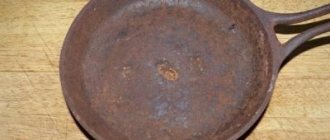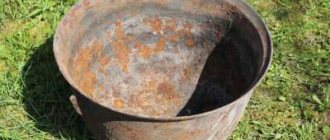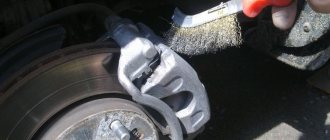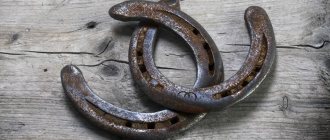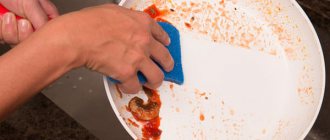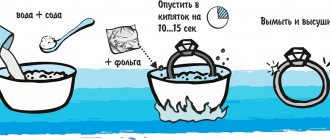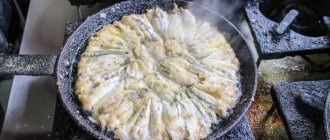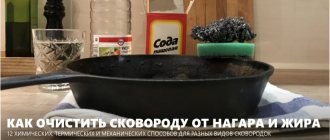Thick-walled cast iron frying pans are valued for their durability and ease of cooking.
However, for a number of reasons, rust may appear on their surface. To remove plaque, use folk methods or special household chemicals.
To protect cast iron from re-oxidation, it is necessary to take preventive measures and properly care for cookware.
We'll tell you how to clean a cast-iron frying pan from rust in this article.
Why does a rusty coating appear?
Why does rust appear on cast iron? Corrosive deposits on the surface of cast iron frying pans can appear for several reasons:
Manufacturing defect. It makes itself felt if low-quality material was used in the manufacture of dishes or the rules for polishing the product were violated.- Illiterate first operation. It consists of ignoring the calcination of the frying pan with oil after purchase.
- Storing food in containers. A wet surface and the presence of food for a long time lead to metal corrosion.
- Rare use of the frying pan for its intended purpose. The less often cast iron is heated, the more chemically active it is.
Distinctive features of cast iron
Cauldrons, braziers, and cast iron frying pans are easy to identify - they are of impressive weight, with thick walls and bottoms. Food cooked in such dishes has an excellent taste and smell, does not burn, remains warm for a long time, and “arrives” after cooking.
The main advantages of the material:
- slow heating, uniform heat distribution (food does not burn in the place where heating occurs);
- the dishes are made of pure cast iron or covered with enamel (usually cauldrons);
- durability and high strength (lasts for decades);
- environmental friendliness (harmlessness) – does not release hazardous elements into food and air;
- easy care;
- does not scratch - spoons, knives and forks will not damage the coating.
Now let’s recall the main problems of cast iron cookware:
- tendency to corrosion - objects not covered with enamel rust when exposed to excess moisture;
- fragility - can break if dropped or suddenly changed in temperature;
- absorbs food odors - storing cooked food in a frying pan is not recommended.
Many people think that a heavy frying pan is difficult to handle. Frying pancakes on it is really not easy - it requires strong hands. But an even blush, lots of holes and wonderful taste are guaranteed.
Folk remedies for use at home
At home, you can use different ways to clean cast iron from rusty deposits. Each method has its own level of effectiveness and complexity of application. Common features of folk remedies are low financial costs and accessibility.
Baking soda
The powder is poured onto the bottom of the dish and a small amount of water is added to form a paste . Rub this product into the rusty stains with a soft sponge, and then rinse the container. If traces of rust remain, repeat the soda treatment.
The method is simple, but effective only when corrosion has begun. It is difficult to remove a thick layer of rust using soda.
How to remove table salt?
Regular finely or coarsely ground salt also helps remove rusty deposits.
The product in the amount of 3-5 tablespoons is poured into a bowl and heated over a fire. Next, dilute the salt with water to a thick paste and rub the damaged areas with a sponge .
If the rust cannot be removed the first time, repeat the cleaning with salt or any other suitable means.
Vinegar
To clean, pour a small amount of acetic acid into the dishes and leave to soak for several hours.
The method is one of the most effective , since iron oxide and hydroxide react with acetic acid, as a result of which rust disappears from the surface of the frying pan without heat or physical effort.
However, this method has two limitations. Firstly, for safety reasons you should not use vinegar essence. Secondly, it is undesirable to carry out cleaning without an exhaust hood and with the windows closed.
How to get rid of it with Coca-Cola?
A container larger than a frying pan is filled with Coca-Cola and heated. Lower the frying pan into the dish and leave for 40-60 minutes.
Phosphoric acid contained in the drink reacts and reduces the amount of oxidized iron . Instead of Coca-Cola, you can take any other carbonated drink with similar qualities. The method is considered safe, simple and effective.
Mechanical cleaning
Rust can be scraped off the surface of the pan with steel wool or a stiff brush. The dishes are rubbed until the orange coating completely disappears.
The method is the cheapest, but labor-intensive , as it requires physical effort.
An alternative to a metal sponge can be a sanding machine with a fine sandpaper attachment. The method is effective and appropriate if a thick layer of rust has formed on the dishes, which is difficult to remove with a soft converter.
Method 1: preparing a new frying pan for use
Keep the pan indoors for several hours.
|
Wash dishes with detergent.
Make it a habit to wipe down all cast iron cookware immediately after washing. This will prevent the formation of rust and extend the life of the products. |
Place the frying pan on the stove over medium heat (in electric stoves at medium temperature).
Don’t forget that we are going over how to clean cast iron frying pans before first use; you don’t need to burn old ones like that |
The surface becomes lighter as the grease burns out..
|
| Remove the pan from the stove . She's hot, do it carefully. Place the product on the stand and wait until the metal has cooled to the point where it can be handled |
Wash the pan again.
|
Place the frying pan on the stove and heat it well.
|
Special formulations
Liquids and concentrates designed to remove rust deposits contain potent substances. They provide high efficiency, but require precautions.
When handling products, you should wear rubber gloves and rinse the dishes thoroughly after cleaning.
Sanita Anti-rust
A well-known Russian brand produces a gel-like universal rust remover for metal surfaces. The concentrate contains organic acids, including oxalic acid . They account for up to 30% of all components. The amount of nonionic surfactants is less than 5%.
The gel is applied with a sponge or brush to the rust and left for 3-4 minutes to react. The maximum holding time (with a thick rusty layer) can be 10 minutes. Next, the surface is cleaned with a brush or coarse sponge and thoroughly washed in water. A 500 ml bottle is sold in stores for 85-105 rubles.
Cillit BANG
A universal product made in Russia, designed to remove rust and limescale. The gel formula contains no more than 5% nonionic surfactants. The active substance is oxalic acid.
To clean the surface, it is first moistened with water. Apply Cillit BANG to a sponge and wipe the areas covered with rust. Exposure time depends on the thickness of the plaque and ranges from one to five minutes. After this, the dishes are washed in a large volume of water. The cost of a 450 ml bottle averages 230 rubles.
Syntilor Ruggine
Liquid concentrated rust remover from a Russian manufacturer. The product is intended for cleaning metal surfaces. The composition does not contain chlorine or mercury containing substances. The rust converter is considered safe for human health and the environment and can be discharged into the public sewer system.
Before use, shake the product, dilute it with water in a ratio of 1:3 and apply it with a sponge to rusty spots . Leave the dishes for 5-8 minutes for the reaction to take place. Next, clean the surface with a stiff brush. Complete the procedure by rinsing with water. The average price for a bottle weighing 1 kg is 300 rubles.
Method 4: clean with chemicals
Restoring a cast iron frying pan is done using the following:
|
Prepare dishes that can be cleaned.
|
Add soda ash, glue and soap to water.
|
If the products are not completely placed in the solution, turn them over every 10 minutes.
|
Clean off any remaining dirt while the cast iron is still hot..
|
What should not be used and for what reason?
It is not recommended to use foaming detergents to clean and wash cast iron cookware. They provide a degreasing effect and remove protective oil impregnation. Open pores in cast iron allow moisture to reach the metal and initiate the corrosion process.
Sharp temperature contrasts are taboo. A heated cast-iron frying pan should not be immediately exposed to running cold water. This degrades the quality of the alloy and makes it more brittle.
Do not use metal brushes unless absolutely necessary . They damage the protective coating and make the cast iron surface vulnerable to moisture and chemicals.
How to clean a cast iron frying pan from burnt food?
An easy way to clean a cast iron skillet is to dip it in a solution of equal parts vinegar and water, then add a couple of tablespoons of detergent. After two or three hours, the soot will easily go away.
Interesting materials:
How to turn off the computer using the keyboard? How to disable User Account Control? How to disable currency conversion in PayPal? How to disable Launch CSM? How to disable unnecessary programs in autorun? How to disable scaling for applications? How to disable zooming in Google Chrome? How to disable the cheat codes menu in Mount and Blade Warband? How to disable mi browser when swiping up? How to disable Microsoft News?
How to restore the protective layer?
After any cleaning, rinse the pan with plenty of water and wipe dry with a towel or napkin. After this, they begin to create a protective layer that protects the cast iron from corrosion.
The work includes several steps:
heat the oven to 180 degrees;- grease the frying pan with a thin layer of vegetable oil;
- place the dishes in the oven upside down;
- heat the pan for an hour;
- keep the dishes in the oven until completely cool;
- Rinse the pan with warm water and wipe dry.
To coat the frying pan, you can use any type of vegetable oil, except olive oil (it smokes when fired), as well as any type of animal fat.
Oil and melted fat penetrate into the micropores of cast iron, creating a waterproof coating. This method of protection must be used after each cleaning of dishes, regardless of the product used.
Getting rid of carbon deposits and rust
Many housewives suffer for hours scraping thick layers of soot and rust from an old frying pan. However, you shouldn’t waste your energy, because the most effective way to deal with burnt fat is to put kitchen utensils in the fire. It is necessary to wait until the cast iron becomes red hot, after which all carbon deposits and rust will disappear without a trace. It is extremely important not to cool the cast iron in cold water after this, otherwise it may simply crack. Allow the pan to cool on its own at room temperature.
Corrosion prevention and care recommendations
To ensure that a cast iron frying pan does not cause problems, it is necessary to adhere to the following care rules during its entire service life:
- Cast iron cookware is not intended for storing food, as a humid environment provokes corrosive processes. Food is removed from the pan immediately after cooking.
- After cooking, a frying pan that has not yet cooled down should not be placed under cold water immediately; it needs time to cool naturally.
- It is recommended to maintain the oily impregnation throughout the entire service life. If the protective layer has disappeared, it must be restored.
- It is advisable not to fry or simmer foods with an acidic reaction (tomatoes, pickles, citrus fruits, sauerkraut) in cast iron dishes.
- If the food is burnt, then fill the frying pan with water, heat it over the fire and give it time to soak. This will allow you to do without harsh washcloths and soap, which remove the protective layer.
Method 2: restoring the coating of the pan
Let's figure out how to restore a cast iron frying pan.
|
| Pour table salt into the pan . Use the cheapest option. There is no need for fine grinding here. The main thing is that the salt covers the bottom and the layer thickness is at least 1 centimeter |
| Place the pan on the stove . Turn on medium heat and heat the salt until it crackles |
Mix the salt with a spoon.
|
Turn off the stove and wait until the salt cools down a little.
|
| Lubricate the surface with refined vegetable oil . After this, turn off the stove and let the pan cool down |
Leave the pan for a day.
|
Adviсe
When cleaning, it is recommended to give preference to more gentle methods and means . The most aggressive methods include mechanical grinding, so it should be used only as a last resort.
After restoring the protective coating, cleaning gels should not be used. They remove the oily layer.
Rinse the pan under running hot water, using a soft sponge at the same time. After removing the rust, the container should be thoroughly dried with a towel or by heating over a fire.
